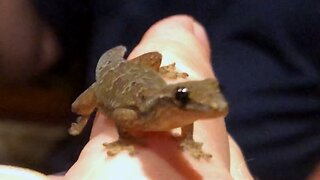Premium Only Content

Very chill camel enjoys a tasty snack
This camel is completely relaxed as he spends the day at a fair in Chilliwack, British Columbia. He's very comfortable with people and he happily allows anyone to pet him and scratch his ears. He'll also happily take a handful of fresh, green hay. He munches contentedly as the people passing by stop to get a close look.
Camels are sturdy mammals known for their distinctive physical characteristics, which enable them to thrive in harsh desert environments.
Camels are large, with adult camels standing about 6 to 7 feet (1.8 to 2.1 meters) tall at the shoulder. They can weigh between 880 to 1,320 pounds (400 to 600 kg).
One of the most distinguishing features is the hump on their back. There are two main species of camels. A dromedary (Arabian) Camel has one hump. A Bactrian camel has two humps. A camel's humps store fat, which can be converted into energy and water when food is scarce.
Camels have large, tough mouths that are well-suited for eating thorny desert vegetation. They have slit-like nostrils that can close to protect against sand and dust. Their eyes are large, with long eyelashes that help keep sand out, and a third eyelid (nictitating membrane) that provides additional protection. Camels have long, powerful legs, which help them walk long distances and carry heavy loads. Their broad, flat feet are specially adapted for walking on sand, with tough, leathery pads that prevent sinking. Camels have thick fur that helps insulate them from both the heat and cold. In the summer, they shed much of this fur to keep cool.
Their coat color ranges from light brown to beige, providing natural camouflage in desert environments. Camels are highly adapted to conserve water. They can drink large amounts of water quickly (up to 40 gallons in one go) and can survive for long periods without drinking.
Camels can tolerate body temperature fluctuations that would be fatal to most other animals, which helps them avoid sweating and thus conserve water.
These characteristics make camels well-suited to life in arid and semi-arid regions, where they have been used by humans for transportation, food, and other resources for thousands of years.
-
 2:02
2:02
WildCreatures
2 days ago $0.73 earnedFriendly gecko takes an extreme liking to woman in restaurant
1.51K3 -
 LIVE
LIVE
Timcast
35 minutes agoKyiv ATTACKED, Trump Tells Putin “STOP,” Slams Zelenskyy For REFUSING Peace Ft Sebastian Gorka
30,229 watching -
 LIVE
LIVE
Steven Crowder
3 hours ago🔴 Trump Lays Down the Law on Ukraine & Russia: Take the Deal or We Walk
30,993 watching -
 LIVE
LIVE
Nerdrotic
2 hours agoNerdrotic Nooner 481
623 watching -
 LIVE
LIVE
The Charlie Kirk Show
28 minutes ago"Disparate Impact" Must Die + "Maryland Dad" Human Smuggling | Hassett, Hilton, Dr. Slack | 4.24.25
3,482 watching -
 LIVE
LIVE
Flyover Conservatives
11 hours agoExposing the Left’s Agenda: Border Chaos, Gun Control, and 2028 Predictions - Nick Adams | FOC Show
192 watching -
 1:00:20
1:00:20
The Rubin Report
1 hour agoThis Fight Over Trump’s Birth Rate Plan Was So Big It Could Be the End of This Host of 'The View'
8.01K17 -
 LIVE
LIVE
The Shannon Joy Show
2 hours ago🔥🔥Medical Murder In America, Will You Survive A Hospital Stay? The Grace Schara Story, Live Exclusive With Her Dad Scott Schara As He Challenges The COVID Kill Protocol In MASSIVE Court Case This June🔥🔥
192 watching -
 LIVE
LIVE
Benny Johnson
1 hour agoIt Begins: DOJ Will Prosecute CRIMINAL Deep State Intel Criminals, Pentagon EXPOSED on Hidden Camera
9,080 watching -
 LIVE
LIVE
The Mel K Show
1 hour agoMORNINGS WITH MEL K - 4/24/25 Ending Disparate-Impact for Meritocracy, Turning the Tables on Lawfare, Individual Liberty is Our Birthright
582 watching